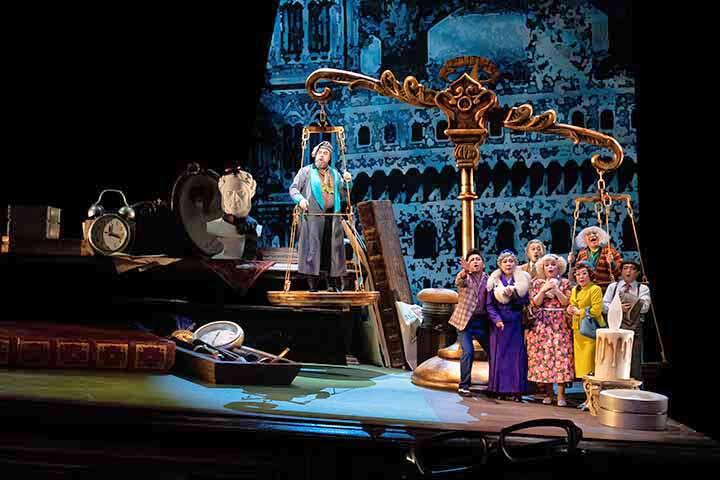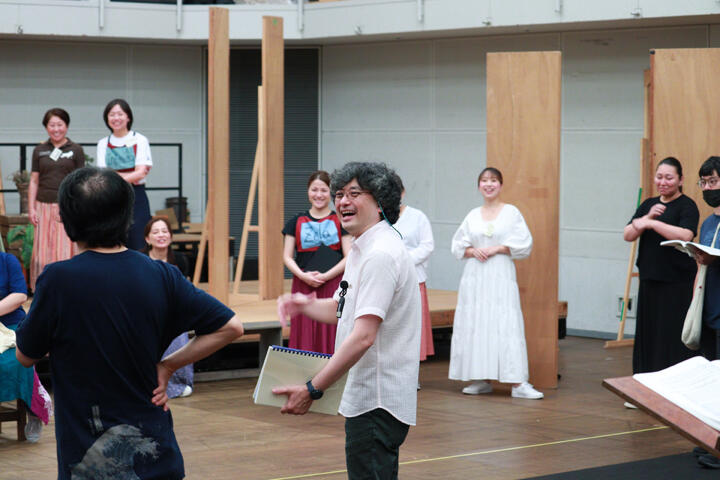Interview: AGUNI Jun on "Suor Angelica" and "L'Enfant et les Sortilèges"
 ―The season opens with a new production of a double bill of Puccini's Suor Angelica and Ravel's L'Enfant et les Sortilèges. What is the appeal of such a double bill?
―The season opens with a new production of a double bill of Puccini's Suor Angelica and Ravel's L'Enfant et les Sortilèges. What is the appeal of such a double bill?
For the audience, the appeal is that they can enjoy two very different works in one day. In the operatic repertory, there are several wonderful short operas that last a little over one hour but are not substantial enough to stage on its own. So by combining such works, people will have the luxury of enjoying two operas in one sitting.
―You also directed a double bill of Zemlinsky's Eine florentinische Tragödie and Puccini's Gianni Schicchi in 2019. What are the difficulties of combining two operas by different composers?
When developing the concept of a single opera, there is a continuous flow even if it is a lengthy work. But with a double bill, especially by different composers, even if each opera is very short, they are often disparate, so one has to come up with two totally new productions and this can certainly be challenging. But double bills can also be fun and it's an opportunity to be inventive.

Eine florentinische Tragödie (2019)

Gianni Schicchi (2019)
―In the previous double bill, the common theme was Florence. This time in Puccini's Suor Angelica and Ravel's L'Enfant et les Sortilèges, the theme is the love between the mother and child.
Musically, Puccini and Ravel are worlds apart, so it's tough to create a staging with a common theme. Visually, they will seem like two different works, but beneath the surface, there is a similar theme. Although the two stories are totally different, I feel there are structural similarities.
―Suor Angelica is a story set in an Italian convent in the late seventeenth century.
The opening of this opera portrays the everyday life of the nuns in the convent, who all seem similar and characterless. But actually, each exists as an individual. Each has her own habits and desires ― small desires such as wanting to eat something nice or wanting to cuddle a lamb ― but as nuns serving God, they must abandon all worldly desires. There is a scene where Angelica preaches this to the other sisters. But in fact, her circumstances are the most serious. Some years ago, she fell in love with a man and bore a child out of wedlock. In the natural world, this is a totally ordinary thing, but within the rules of the human world, this becomes a sin.
―The fact that Angelica was from an aristocratic family made it even more unforgivable.
In this opera, I'm particularly concerned about the final scene. In the second half the opera, Angelica learns of the death of her child, with whom she was separated at birth. The only reason she had endured her life in the convent after having had to renounce everything was because she believed that her child was being brought up with care. But now that her child was dead, she has lost the reason to live. In despair, she makes a poison from the herbs in the garden and takes her own life. However, suicide is not allowed as a Catholic. It's a sin that will result in hell. When she realizes that she may not see her child forever, she becomes distressed. The stage direction in the libretto indicates that in the final moment, the Virgin Mary and her child appear and they take Angelica to heaven.
―In the libretto, it says that the child comes towards Angelica, doesn't it?
That's right. However, when one reads the letters Puccini wrote at the time, it seems that he wasn't entirely convinced about this stage direction. Perhaps he wanted to express this miracle in a different way, in a visual sense as well. I also think that this final miracle should be something that can only be seen by Angelica.
―I also think that the mystical expression of the music in the final scene fits with your interpretation. We look forward to how you will stage this scene. The set designs are by Atsumi Yokota and costumes by Emi Masuda. Will it be a traditional period setting?
Largely yes. However, although the sets seem realistic, there are some places where one can't actually go where one expects. There is a sense that one ends up where one started from, rather like an Escher drawing. This indicates that the nuns have no choice but to stay in this confined space.
From the concept explanation of Suor Angelica

From the rehearsal of Suor Angelica
―What are your ideas about the second opera, Ravel's L'Enfant et les Sortilèges?
The design and setting will be completely different because this opera deals with fantasy. For me, L'Enfant et les Sortilèges reminds me a little bit of Pinocchio.
―The Adventures of Pinocchio is a well-known story in Italy where you lived as a child. Where do you see the similarities?
Pinocchio is a story about growing up. Originally Pinocchio is a wooden puppet, which becomes a real boy at the end of the story. As he grows up, he goes through various experiences, often making mischief. His father, Geppetto, as well as the Talking Cricket and other characters advise him on what he should and shouldn't do, but he can't do as he is told. In that sense, one can say Pinocchio is a bad child, but is there really any well-behaved child in this world who grows up doing everything they are told to?
―That's true.
I think it's the same with young people, but in order for children to grow, it's not enough to just do what they are told by others. They have to go through various experiences and make their own judgment. I think this is what L'Enfant et les Sortilèges is about too. As I was studying the work for this production, I discovered that although it's called magic (=Sortilèges), the theme is actually about the various obstacles that a child experiences as he/she grows up. For example, when the child breaks the pendulum of the Grandfather Clock, it cries out, "I don't know what the time is now". But if you think about it, adults (especially in the modern age) are always pressed for time.
―Most people are, yes.
It's the same with numbers. When the child tears up his arithmetic notebook, the numbers come out and torment him. But adults are also constantly tormented by numbers. In my case, for example, finishing a piece of work by a certain date, not exceeding the rehearsal hours, stressing over the budget or the attendance numbers of the production etc...(laughs)
―I see. The various issues that are portrayed symbolically in the opera can be related to the process of growing up.
Although the first half of the opera is set indoors, the story moves outdoors in the second half, and there the animals and nature that the child has hurt in the past start complaining to him. Although it wasn't intentional, the child's ego has resulted in a lot of cruelty. The list of complaints seems to anticipate the environmental issues of today. Although the child wanted freedom, he realizes that he must return to family love, to his mother's love. What happens is that as the animals unite in revenge on him, they start quarrelling amongst themselves and a little squirrel becomes injured in the process. The boy saves the squirrel. The animals, who were the ones seeking justice, end up in infighting.
―Many of those issues are relevant to our age too. How is the mother portrayed?
According to the original stage directions, the mother is represented only by her voice and part of her skirt, and we don't see her face. She never appears on stage in full, which is very intriguing.
―The production will be conducted by Maestro Numajiri Ryusuke, with whom you have collaborated most often. He calls you a director he trusts. How do you see him?
He is really cool when he is conducting. I don't mean how he waves his baton, but what kind of sounds he can produce by his conducting. When he rehearses, the singers immediately sound different. As director, I create the stage through drama and text, and he adds musical drama through singing and playing, and despite our differences, the themes of the text and music come together perfectly. That's really magical. So it's really fun to build the drama together.
From the rehearsal of L'Enfant et les Sortilèges
From the rehearsal of L'Enfant et les Sortilèges
―What's your message for the audience?
Suor Angelica and L'Enfant et les Sortilèges may seem like two separate worlds, but both are profound works in terms of human observation and relevance to our own age. By creating the drama visually, I want to deliver the appeal of these works to the audience. I hope they will enjoy the production.
Interview by Inouchi Mika
Opera ❝Suor Angelica❞ / ❝L'Enfant et les Sortilèges❞
On Stage 1, 4, 7, 9 October.
See here for more information.

